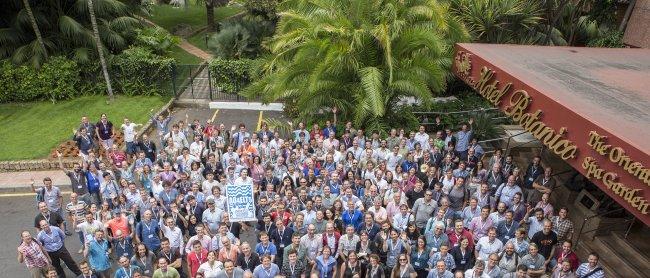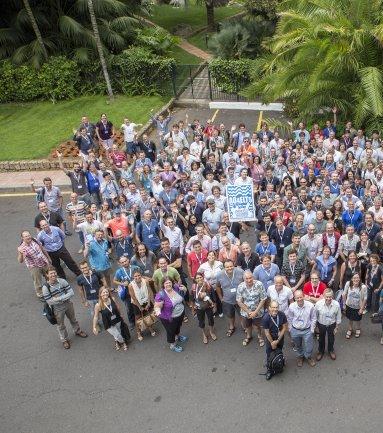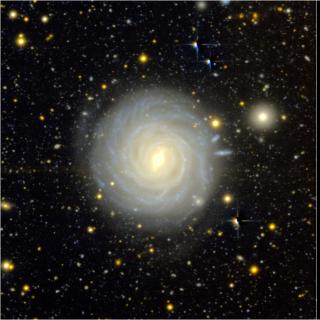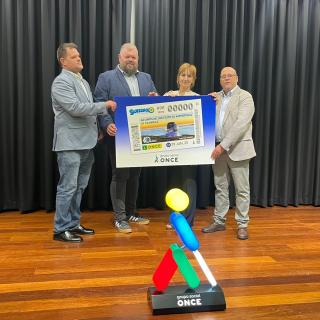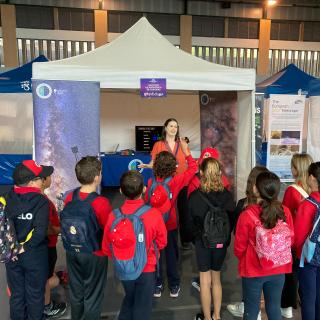Adaptive Optics in a technique which, using deformable optical elements, permits the correction of many of the defects introduced by the Earth's atmosphere in the images taken with a telescope. Atmospheric perturbation causes a loss in the clarity or spatial resolution of the image. This causes a loss in the capacity to resolve objects, in other words to make detailed studies of their morphology, and also reduces the ability to detect faint objects, because the image is blurred out into larger sized blobs. Eliminating the perturbations produced by the atmosphere is essentially equivalent to observing from space. For that reason the possibilities offered by Adaptive Optics to astrophysics are enormous.
Aware of the importance to the astronomical community of this technique, the Gran Telescopio CANARIAS (GTC) also included it in its design and, at the present time, all the projected extremely large telescopes are developing systems of Adaptive Optics suitable for their needs. For this reason, there are regular conferences about this technique and for the past week the fifth edition of AO4ELT5 (Fifth Adaptive Optics conference for Extremely Large Telescopes) has been held in Tenerife.
The conference brought together over 280 specialists from 21 countries in the field of engineering applied to Adaptive Optics which will be incorporated in the future giant telescopes currently in their design phase, such as the solar telescopes DKIST and EST, and the night-time telescopes GMT, TMT and E-ELT. This brought the presence among the participants of some of the leaders of these projects, among them Gary Sanders (Thirty Metre Telescope, TMT), Antonin Bouchez (Giant Magellan Telescope, GMT) and Manuel Collados (European Solar Telescope, EST), as well as representatives of many institutions working on the most advanced scientific instruments. The IAC has a 20% participation in HARMONI, a first light instrument for the Extremely Large European Telescope (E-ELT). These are major challenges for the IAC itself, and indeed for the scientific community. Putting in place Adaptive Optics is essential to optimize the output of this instrument. This is the reason why the Principal Investigator of this instrument, Niranjan Thatte, of the University of Oxford, attended the meeting with part of his team.
Deformable mirrors for the EST
During AO4ELT5, the main parameters of the Adaptive Optical system for the EST were presented. This is the future 4m European Solar Telescope, which should be installed in the Canary Island Observatories, and for which a 1:50 scale model was on show at the conference. With its five deformable mirrors, it is the most complete and ambitious solar telescope under design at the present time. The aim is to correct the images generated by the telescope in real time and which even in the best observatories are distorted by the turbulence of the Earth's atmosphere. The Adaptive Optical system of the EST is designed to work optimally at the shorter wavelengths of the visible spectrum and throughout the day. This latter aspect is particularly important because solar observations made when the sun is near the horizon (during the early morning or late evening) are affected differently by the atmosphere from those carried out around midday, when the sun is nearer the zenith. Using this technique the EST will produce images of unprecedented quality during long periods of time, which will augment significantly its scientific use.
“Women in Observatory”
Among the technical and scientific sessions of this conference, whose scientific organizing committee was chaired by the IAC engineer Icíar Montilla, there was a session dedicated specifically to the participation of women in the field of Adaptive Optics. During the session, a presentation was made of a breakdown of the numbers of participation of women engineers and scientists in AO4ELT5. The astronomer Pascale Hibon, a technician at the European Southern Observatory (ESO) in Chile, presented the recently created blog “Women in Observatory” whose aim is to collect personal experiences of women astronomers and engineers who work in big observatories.
Technological specialization
This conference was the most successful of those in the series celebrated until now, both for its scientific interest and for the number of individuals and institutions participating (115 in the latter case), as well as the level of patronage by international technological companies. The degree of specialization demanded by the major projects of international telescopes has made the international community dedicated to Adaptive Optics grow significantly in recent years. This implies that Tenerife has been, for the past ten days, the world focus on optical engineering applied to astronomy.
The choice of Tenerife as the site of AO4ELT5 was not pure chance. The sky quality at the Canary Island Observatories, which are part of a small group of the best observatories in the world, was a key factor. The presence of telescopes such as the GTC, currently the largest optical-infrared telescope in the world, and the forthcoming installation of frontline projects such as the CTA-North network and EST, also supported the decision. After the scientific sessions, working meetings, and visits to the Teide and Roque de los Muchachos Observatories the level of satisfaction expressed by those attending, and by the organizers is very high. This challenge will be taken up by the candidates to celebrate the sixth meeting in the series in 2019 in Québec (Canada).
Interviews and previous press releases:
Interview with Norbert Hubin (VLT)
Interview with Antonin Bouchez (GMT)
Interview with Gary Sanders (TMT)
